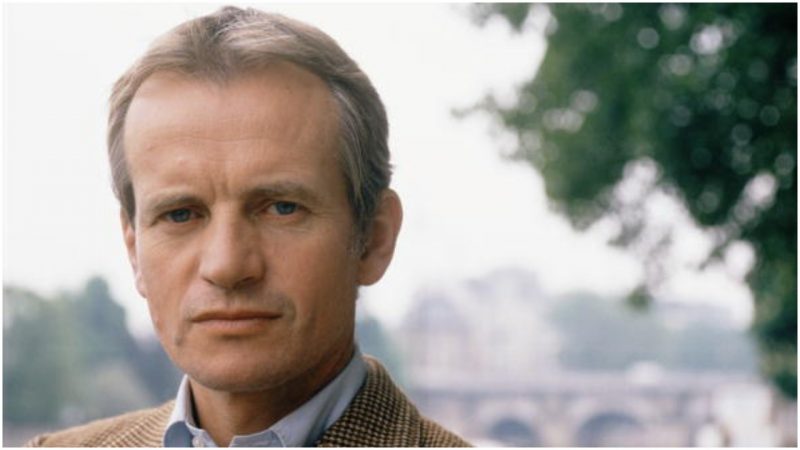Sometimes the things we did or saw in our childhood inspire the course of our adult life. Childhood memories and dreams are inspirational. They often have the power to move us and shape us into the persons that we would like to be. Bruce Chatwin became a renowned travel and fiction writer, but his journey began when he was a child. While staying at his grandparents’ house, Chatwin came across a piece of fossilized bone that belonged to a giant sloth found in Patagonia. Since then, the wish to visit this part of the world never left him, until he finally made it there and wrote a masterpiece about his experiences.
Chatwin was born on May 13, 1940, and his childhood was filled with a lot of moving around, mainly because of the war. It was during one of these moves with his mother that he was introduced to the fossilized bone that inspired him to travel and write. Chatwin was not the best student, but during his schooling he showed a great interest in drama, Latin, Greek, and Ancient History. He hoped to study the classics at Oxford one day, but circumstances moved him away from this idea. His father took his son’s future into his own hands and managed to secure for him a job at Sotheby’s, one of the most famous auction houses in the world.
It soon turned out that Chatwin was a natural for this job. His knowledge and interest in art and antiquities made him the head of two of Sotheby’s departments: Antiquities, and Impressionist Art. Chatwin was the future of the company; he had a great eye and became very skilled at detecting forgeries. Many considered him poised to be the next chairman of the company. On a personal level, it was at Sotheby’s where Chatwin met his future wife, Elizabeth Chanler.
Career-wise, things didn’t look so good from Chatwin’s perspective. During the 1960s he was getting more and more dissatisfied with his job. He found an escape from boredom and work-related stress on his professional trips around the world. While traveling to places such as Afghanistan, he often wandered through the local markets and shops in a quest for antiquities that he would later sell for some extra money.

An interesting chapter in his life was his 1965 trip to Sudan. There he saw nomads for the first time, and immediately became fascinated by their lives. This fascination with the nomads stayed with him for the rest of his life. He even did a study in which he tried to find out why it is in human nature to be nomadic.
Nicholas Shakespeare, who wrote Chatwin’s biography, explains the next chapter of his life. The following year Chatwin decided to resign from Sotheby’s. Peter Wilson, the chairman of the auction house at the time, often used Chatwin and his charm to persuade rich customers to spend vast amounts of money at the house. Chatwin despised being put into this kind of situation. Besides this, he always wanted to be a manager at Sotheby’s, but after they made him only junior director, he felt like he wasn’t awarded enough for his work. Third, but not least, Chatwin was strongly opposed to some shady and illegal art dealings allegedly happening at the auction house.
After this, he studied archaeology at the University of Edinburgh but realized that this was not for him. Between 1969 and 1972, Chatwin traveled a lot, looking for his true calling. He always took photos of his journeys and once, after a trip to Mauritania, he tried to send the photographs to the Sunday Times Magazine. It was during this period when he realized that he wanted to be a writer and to fulfill one of his childhood dreams.
Chatwin’s photographs weren’t interesting enough for the magazine, but the editors did like Chatwin’s personality and offered him a job. He became the Sunday Times Magazine art and architecture adviser, responsible for coming up with article ideas for certain sections of the magazine. The job was perfect for him. He traveled a lot, did research on a variety of interesting subjects, and interviewed people. Among those people was a 93-year old architect and designer called Eileen Gray. Chatwin interviewed her in 1972, in her Paris apartment. There, he saw a painting of the map of Patagonia. He commented that he always wanted to go there and Gray replied that she had the same wish. She told Chatwin to go there for her and fulfill hers and his long-time wish.
An opportunity arose two years later, and Chatwin boarded a plane to Lima, Peru, from where he later headed south to Patagonia. He sent a letter to Mrs. Gray and informed here that he had begun the adventure of his life. Chatwin was so overwhelmed by this journey that he even ceased to be a regular correspondent for the Sunday Times Magazine.
Chatwin stayed for six months in the region of Patagonia. Shared between Chile and Argentina, Patagonia’s otherworldly landscape cannot be seen anywhere else. Even today, this is one of the most scarcely populated areas on the planet. Chatwin spent his time there collecting the life stories of the settlers who came there from all around the world to start a new life. He gathered these personal stories, together with his accounts of the places and people he saw, into his first successful book: In Patagonia (1977). To make a full circle and connect his childhood with his present, Chatwin tried to find his own fossilized piece of giant sloth bone.
When In Patagonia was published, it received enthusiastic reviews; the New York Times called it a “‘masterpiece of travel, history, and adventure.” Some people, especially the locals from Patagonia, declared that the book was a work of fiction, explaining that many of the characters and situations described in it are not real. Chatwin, on the other hand, never claimed that his book was purely a factual travel book. In fact, he once described it as a book about both a real and symbolic journey. Nevertheless, many contemporary writers and critics credited Chatwin as someone who reinvented the genre of travel writing, while others said that his books could not settle into any genre. His work is nomadic, just as his life was.
The Songlines is another noteworthy book by Chatwin. This one is about his experiences with the Aborigines in Australia. It became a bestseller, and like its predecessor, it’s a combination of real experience and imagination.
Chatwin often mixed fact with fiction, but he admitted it. After all, what is travel if not a story situated in the personal cosmos of the traveler, created by the experiences and memories one gathers. It has its own facts and rules. Chatwin did his best to introduce us to his own cosmos, to the way he saw the world we live in, and that could be better than any tourist guide.
